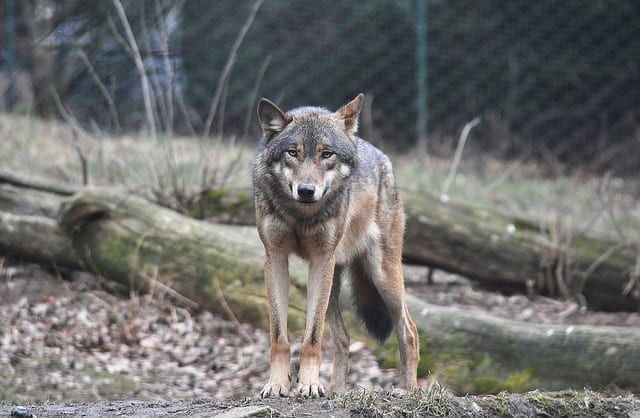
There’s nothing on earth quite as powerful as those big, bright puppy dog eyes your dog gives you. Have you ever wondered why that is? A team of university scientists and researchers proposed a few interesting explanations.
A study published in the journal Proceedings of the National Academy of Sciences (PNAS) found a distinct difference between wolves and dogs. Comparing the anatomy and behavior of dogs and wolves, researchers found that the facial musculature of both species was similar except above the eyes. Dogs have a small muscle that wolves don’t which allows them to intensely raise their inner eyebrow.
Hence: puppy dog eyes.

Obviously, this is an adorable feature, but it’s more than that. This special muscle helped form dogs’ incredible relationships with human beings.
How The Relationship With Human Beings Changed Dogs’ Anatomy
According to the research, this inner-eyebrow-raising movement triggers a nurturing response in humans because it makes dogs’ eyes appear larger. Larger eyes remind us of our babies and resemble the facial movements people make when they’re sad. When we see dogs’ faces as expressive, we feel closer to them.
Another possible explanation is that the muscles help expose the whites of a dog’s eyes, which appeals to humans as the only creatures whose eye whites are constantly exposed.

Though it benefits them greatly, the development of this muscle likely results from unconscious human preference. Co-author and anatomist Adam Hartstone-Rose said:
“These muscles are so thin that you can literally see through them—and yet the movement that they allow seems to have such a powerful effect that it appears to have been under substantial evolutionary pressure. It is really remarkable that these simple differences in facial expression may have helped define the relationship between early dogs and humans.”
Clearly, faces and facial expressions are very important to how humans interact. Dogs, consciously or not, figured that out.
As part of the study, the team observed wolves and dogs in captivity as they interacted with people. While wolves occasionally made the “puppy eyes” expression with “low intensity,” dogs made it much more frequently and with more intensity, indicating the look is an important part of human-dog interaction.
Evolutionary psychologist Professor Bridget Waller notes:
“Our findings show how important faces can be in capturing our attention, and how powerful facial expression can be in social interaction.”
An Amazingly Fast Evolutionary Advantage
Evolutionary processes have been the focus of study for a long time. There’s still a lot we don’t know, largely because soft tissue like muscle doesn’t usually survive in the fossil record. The newer study introduces some groundbreaking information about the dog/person relationship.
Typically, evolution is a very slow process. However, dogs’ and humans’ relationship began only tens of thousands of years ago (a small amount on the universal scale.) That makes the development of this special muscle quite fast.
Co-author Rui Diogo, an anatomist at Howard University said:
“I must admit that I was surprised to see the results myself because the gross anatomy of muscles is normally very slow to change in evolution, and this happened very fast indeed, in just some dozens of thousands of years.”

Lead anatomist Professor at Duquesne University Anne Burrows also found this distinct difference between dogs and their wolf cousins fascinating.
“This is a striking difference for species separated only 33,000 years ago and we think that the remarkably fast facial muscular changes can be directly linked to dogs’ enhanced social interaction with humans.”
This amazingly quick evolutionary development that strengthened dogs’ relationship with humans could be the reason for their species’ survival. Another co-author and psychologist Dr. Juliane Kaminski summarized:
“When dogs make the movement, it seems to elicit a strong desire in humans to look after them. This would give dogs, that move their eyebrows more, a selection advantage over others and reinforce the ‘puppy dog eyes’ trait for future generations.”
To prove this point further, evidence indicates that dogs with bigger, more expressive eyes spend less time waiting for adopters in shelters. In my house, dogs with puppy eyes spend less time waiting for treats.
H/T: Smithsonian Magazine
The post Dogs Evolved A Special Muscle That Lets Them Give “Puppy Dog Eyes” appeared first on iHeartDogs.com.
via Whisker Therapy